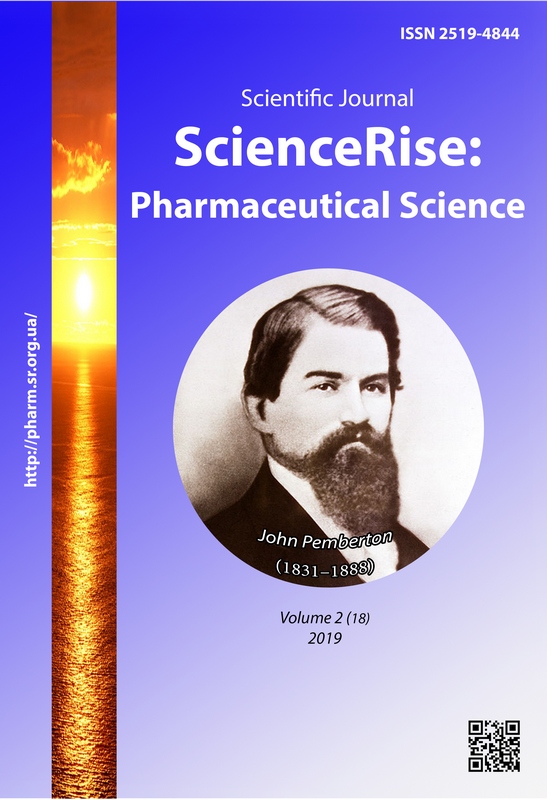Chromatographic analysis of 6-gingerol and 6-shogaol using TLC and HPLC methods
DOI:
https://doi.org/10.15587/2519-4852.2019.165655Keywords:
ginger, Zingiber officinale Roscoe, TLC, thin-layer chromatography, HPLC, high power liquid chromatography, food supplements, qualitative analysis, quantitative analysisAbstract
Nowadays spices are known not only for their taste and flavour, but also for their medicinal value. Zingiber officinale Rosc. (Zingiberaceae family) contains a number of bioactive phenolic constituents, which in pure form or it‘s derivates might be potential antioxidants, in the most cases scientists discover 6-gingerol and 6-shogaol as a major constituents of ginger rhizomes.
Methods. For this investigation we have chosen four different food supplements, containing ginger and one traditional herbal medicine. The presence of two major ginger constituents in the investigation objects were analysed through TLC analysis, which was performed using CAMAG TLC Visualizer and other method was HPLC analysis, which required a high performance liquid chromatographic system Waters 2695 with fotodiode detector Waters 966 PDA.
Results. Our results suggest that ginger-containing food supplements and medicine contain two major constituents which leads to ginger biological active properties. Chromatographic analysis might be useful in providing information about quality of ginger rhizomes and commercial ginger products.
Conclusions. Selected chromatography methods are suitable for qualitative and quantitative evaluation of 6-gingerol and 6-shogaol in dietary supplements and other products
References
- Kubra, I. R., Rao, L. J. M. (2012). An Impression on Current Developments in the Technology, Chemistry, and Biological Activities of Ginger (Zingiber officinaleRoscoe). Critical Reviews in Food Science and Nutrition, 52 (8), 651–688. doi: http://doi.org/10.1080/10408398.2010.505689
- Jelled, A., Fernandes, A., Barros, L., Chahdoura, H., Achour, L., Ferreira, I. C. F. R., Cheikh, H. B. (2015). Chemical and antioxidant parameters of dried forms of ginger rhizomes. Industrial Crops and Products, 77, 30–35. doi: http://doi.org/10.1016/j.indcrop.2015.08.052
- Alam, P. (2013). Densitometric HPTLC analysis of 8–gingerol in Zingiber officinale extract and ginger–containing dietary supplements, teas and commercial creams. Asian Pacific Journal of Tropical Biomedicine, 3 (8), 634–638. doi: http://doi.org/10.1016/s2221-1691(13)60128-8
- Mukherjee, S., Mandal, N., Dey, A., Mondal, B. (2012). An approach towards optimization of the extraction of polyphenolic antioxidants from ginger (Zingiber officinale). Journal of Food Science and Technology, 51 (11), 3301–3308. doi: http://doi.org/10.1007/s13197-012-0848-z
- Patel, D. K., Dhanabal, S. P. (2013). Development of bioanalytical parameters for the standardization of Zingiber officinale. Journal of Acute Disease, 2 (2), 134–136. doi: http://doi.org/10.1016/s2221-6189(13)60113-4
- Salmon, C. N. A., Bailey-Shaw, Y. A., Hibbert, S., Green, C., Smith, A. M., Williams, L. A. D. (2012). Characterisation of cultivars of Jamaican ginger (Zingiber officinale Roscoe) by HPTLC and HPLC. Food Chemistry, 131 (4), 1517–1522. doi: http://doi.org/10.1016/j.foodchem.2011.09.115
- Srinivasan, K. (2017). Ginger rhizomes (Zingiber officinale): A spice with multiple health beneficial potentials. PharmaNutrition, 5 (1), 18–28. doi: http://doi.org/10.1016/j.phanu.2017.01.001
- European Pharmacopoeia (2016). 9th ed. Strasbourg: Council of Europe, 1367.
- Tohma, H., Gülçin, İ., Bursal, E., Gören, A. C., Alwasel, S. H., Köksal, E. (2016). Antioxidant activity and phenolic compounds of ginger (Zingiber officinale Rosc.) determined by HPLC-MS/MS. Journal of Food Measurement and Characterization, 11 (2), 556–566. doi: http://doi.org/10.1007/s11694-016-9423-z
- Nile, S. H., Park, S. W. (2015). Chromatographic analysis, antioxidant, anti-inflammatory, and xanthine oxidase inhibitory activities of ginger extracts and its reference compounds. Industrial Crops and Products, 70, 238–244. doi: http://doi.org/10.1016/j.indcrop.2015.03.033
- Amir, M., Khan, A., Mujeeb, M., Ahmad, A., Usmani, S., Akhtar, M. (2011). Phytochemical Analysis and in vitro Antioxidant Activity of Zingiber officinale. Free Radicals and Antioxidants, 1 (4), 75–81. doi: http://doi.org/10.5530/ax.2011.4.12
Downloads
Published
How to Cite
Issue
Section
License
Copyright (c) 2019 Raimonda Jazokaite, Mindaugas Marksa, Augusta Zevzikoviene, Andrejus Zevzikovas

This work is licensed under a Creative Commons Attribution 4.0 International License.
Our journal abides by the Creative Commons CC BY copyright rights and permissions for open access journals.








